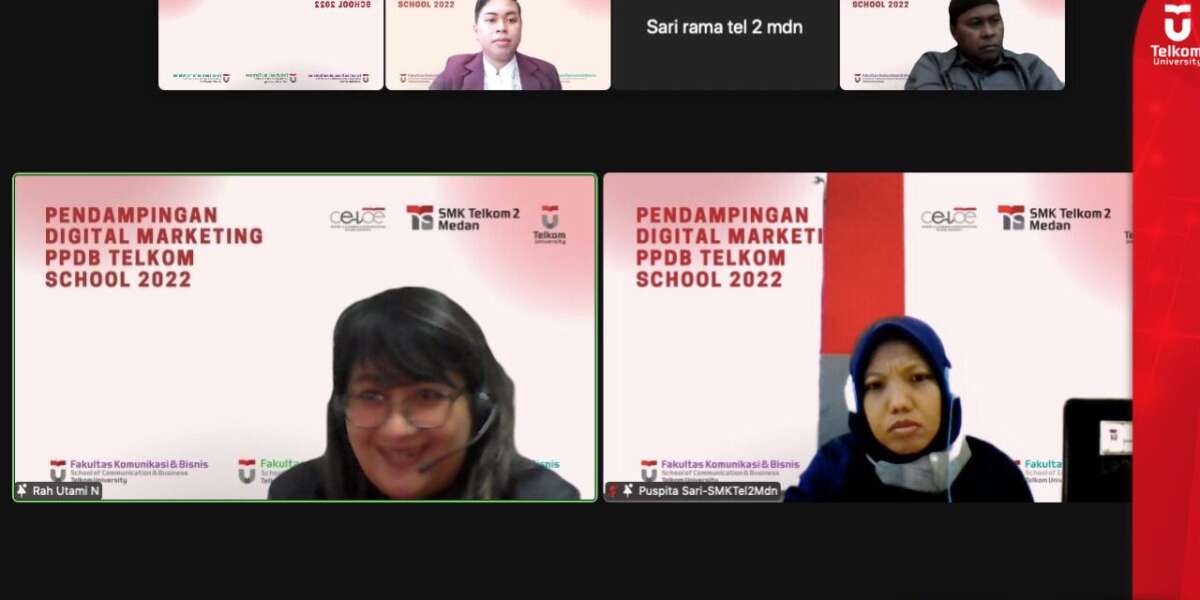The series of community service activities at Telkom University with SMK Telkom 2 Medan is continuing. This week the community service team raised a topic related to the ‘Digital Marketing Context,’ held online at the Zoom meeting on Thursday (24/03). This community service collaborates with three faculties at Telkom University, namely the Faculty of Business Communication, the School of Applied Sciences, and Economics and Business.
This activity lasted two hours and presented three speakers, namely Rah Utami Nugrahani, Berlian Primadani Putri, and Refi Refaldi Windya Giri, to present material, namely Digital Marketing and Analyzing competitors through Marketing Intelligence.
The first material was delivered by Rah Utami Nugrahani or commonly known as Hani. Hani explained that digital marketing promotes products using internet technology and online marketing tactics, such as social media and email marketing. SMK Telkom 2 Medan stated that they had used several platforms such as Instagram, Tiktok, and the Website. To implement content creation, design, and others, SMK Telkom 2 Medan collaborates with students and teachers.
Hani also explained eight stages to creating digital marketing; the first stage is awareness which is to make people interested in our content. After that, there is engagement where we have to be able to make the community participate, and there is interaction in our content, such as if on Instagram, there are likes, comments, shares, and saves.
“To increase interest, you can also take quizzes and give free learning giveaways,” suggested Hani.
Third, there is a subscription, more or less the same as on Youtube. If it is on Instagram, it is followed. Subscribe to this so that people get the latest information from the agencies or people they follow. The next stage is covert, how to get people who have done the three stages above to make their decisions.
Next is excitement. It must be a pleasant experience for potential customers. A response to consumers can make consumers in the future will be interested or not in our content. Then, the existence of repeated purchases, if the fastest possible school is one year. If you are satisfied, you will continue, while if you are not, you will not continue. Seventh is advocating, where when consumers are satisfied and loyal, consumers will become informal marketing agents, such as the presence of the Mouth of word to invite other people to follow our content.
Lastly, there are Promoters. After knowing the eight stages above, Hani also highlighted the customer journey where we must be able to distinguish that when we have a product or service, we must see it from the perspective of our consumers. It is the initial process from consumers interacting to reaching our products.
After the first speaker, the second speaker was Berlian Primadani Putri. Continuing the previous material, Berlian explained that digital marketing is divided into three things: Owned Media (Rumah), which is the media and content that we have and want to get public awareness. For example, websites, emails, social media posts, etc.
We then Paid Media (Vehicle). We have provided interesting content and regularly uploaded it, but the traffic is still low. We need a vehicle where this is a way to find people to be able to stop by the media that we have. Examples such as advertising, sponsorship, etc. The last is Earned Media (Neighbors) which is the media that we get from consumer engagement, such as mentions, shares, reposts, reviews, etc.
They were followed by the third speaker, namely Refi Refaldi Windya Giri, who explained marketing intelligence, which is a strategy that all companies can do to obtain information. That information can be done by collecting data and market analysis following current market conditions. This marketing intelligence is part of the marketing information system, where the information obtained in this marketing intelligence will be processed in the marketing information system. The Ghari meeting ended with a question-and-answer session with the participants.

